#colonial history
Text

baby sheep ! 🐑
📍colonial williamsburg, virginia
**this work is my original photography - please do not reupload without credit or claim as your own**
#fuji#fujifilm#fujinon#landscape#nature#nature photography#photography#art#fuji xt3#sheep#wildlife#farm animals#farm#farmcore#cottagecore#cottage aesthetic#cottage vibes#outdoors#baby animals#baby sheep#williamsburg#colonial williamsburg#colonial history#colonial era#colonial america#virginia#virginia is for lovers#va
20 notes
·
View notes
Text
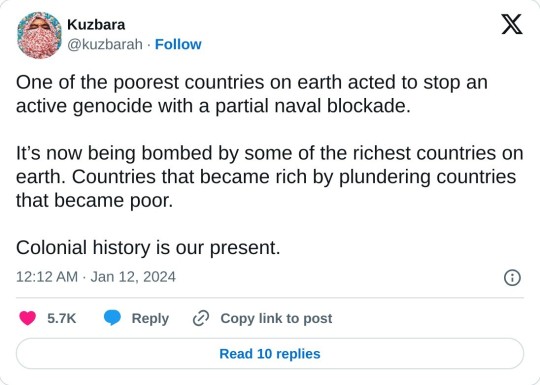
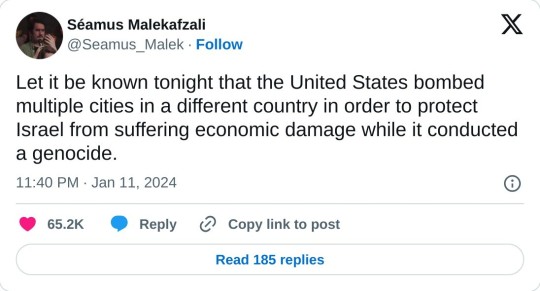
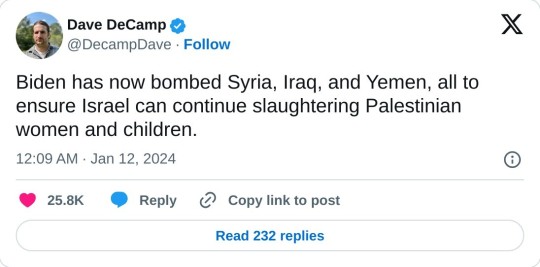

#Yemen#Gaza#Palestine#US#United States#UK#u#United Kingdom#Joe Biden#bombing#colonial history#colonialism#colonial violence#war#Netherlands#Bahrain#houthis
4K notes
·
View notes
Text
Some historical context for Olrox

Okay, let me prephase this with one important message: Castlevania Nocturne made me really happy by making the plot all about colonialism, as colonialism and its fallout and how it influences us to this day is a topic that I am very passionate about. We do not talk enough about it. The US does not talk enough about it because it could make white people feel uncomfortable. And here in Germany we do not talk about it, because we act as if this had nothing to do with us at all.
But the show talks about it and I love it.
And I honestly also gotta say that I love that the BI_PoC character have a concrete cultural heritage. Olrox is Aztec, Annette is Yoruba, and Drolta is Egyptian. Other shows: Please take notes!
But let's talk Olrox, because he is so fucking interesting and amazing!
We know about him that he is Aztec and also that he is 250 years old. Or roughly that old by the time he kills Julia. Which would put either his birth or his turning somewhere around 1530.
Now, the fall of the Aztec Empire has a very exact date: August 13th, 1521. But you should keep in mind that this does not mean that on that day the Aztec's are extinct. To this day there is still 1,5 million people speaking Nahuatl, the language of the Aztecs, and preserving some of the Aztec cultural traditions. It was just that on that day the empire construct fell to Cortez and the Spaniad conquistadors and a lot of Aztecs went into exile to flee the genocide that Cortez was bringing upon them.
The question of course is: Was Olrox still human at this time or was he already a vampire? From his dialogue it is clear that he was at least alive and grown enough to remember the fall of the empire and the distruction Cortez and his men brought upon them. But you can bet it was very traumatic.
I also am assuming he was turned by a white man. Because so far my assumption is that vampirism is an old world thing that got brought to the new world through colonialism. (Mostly because in Dracula's court we do not see any new world vampires.)

Now, the other interesting thing is what he says about his dead lover. The one Julia killed. So, first the "town in Massachusetts" he speaks about is clearly Stockbridge. Which was the town in which many Mohicans have settled during the colonial times, as well as other people from the Iroquois Nations. Now, it should be noted that the Mohicans were not part of the Iroquois alliance and in fact went to war with the Iroquois, but by the time colonialism really geared up there was some cooperation between the Mohicans and Iroquois.
Due to this they were in an alliance with the Oneida (who were part of the Iroquois) by the time of the Revolutionary war. Now, the Revolutionary War created a lot of conflict between the Iroquois nations, because they did not agree which side they should fight on. Of course both sides promised that they could keep their land, but the Mohawk, Onondaga, Cayuga, and Seneca did not trust the colonists and hence sided with the British, while the Oneida and Tuscarora (and through them also the Mohicans) sided with the Colonists.
And the dead lover clearly was among those siding with the colonists. Now, a quick refresher for the non-Americans (and the Americans who slept to history class, which is understandable). The Revolutionary War lasted from April 19, 1775 to September 3, 1783 (which, yes, also means that Julia and Richter probably were in the US during the war the entire time and the "evil" Julia was fighting probably was linked to it). And of course we all know how it ended for the Indigenous people: The colonists won, countless Indigenous folks died on both sides, only to get booted of their land soon after. The Oneida und Mohicans were made to move westwards not soon after the war ended. So, yes, Olrox would have seen that happen.

Now, an interesting thing in his dialogue was when Erzebet said: "We will create a new world." To which he replies: "I have heard that one before." And she says: "This time we are going to make it to last."
And the big question is to what this is refering. Is it refering to the colonialization or is it refering to the revolutionary war? Or something entirely different. In both cases it would be possible. And yes, the American Revolution definitely were claiming to create a new world. But was it that what he refered to or something else?
Well, never the less: Interesting character. Really good writing.
#castlevania#castlevania nocturne#castlevania netflix#castlevania nocturne spoilers#castlevania olrox#american history#history#colonialism#colonial history#aztec
4K notes
·
View notes
Text

690 notes
·
View notes
Note
How did cotton win over linen anyway?
In short, colonialism, slavery and the industrial revolution. In length:
Cotton doesn't grow in Europe so before the Modern Era, cotton was rare and used in small quantities for specific purposes (lining doublets for example). The thing with cotton is, that's it can be printed with dye very easily. The colors are bright and they don't fade easily. With wool and silk fabrics, which were the more traditional fabrics for outer wear in Europe (silk for upper classes of course), patterns usually needed to be embroidered or woven to the cloth to last, which was very expensive. Wool is extremely hard to print to anything detailed that would stay even with modern technology. Silk can be printed easily today with screen printing, but before late 18th century the technique wasn't known in western world (it was invented in China a millenium ago) and the available methods didn't yeld good results.
So when in the late 17th century European trading companies were establishing trading posts in India, a huge producer of cotton fabrics, suddenly cotton was much more available in Europe. Indian calico cotton, which was sturdy and cheap and was painted or printed with colorful and intricate floral patters, chintz, especially caught on and became very fashionable. The popular Orientalism of the time also contributed to it becoming fasionable, chintz was seen as "exotic" and therefore appealing.

Here's a typical calico jacket from late 18th century. The ones in European markets often had white background, but red background was also fairly common.
The problem with this was that this was not great for the business of the European fabric producers, especially silk producers in France and wool producers in England, who before were dominating the European textile market and didn't like that they now had competition. So European countries imposed trade restrictions for Indian cotton, England banning cotton almost fully in 1721. Since the introduction of Indian cottons, there had been attempts to recreate it in Europe with little success. They didn't have nearly advanced enough fabric printing and cotton weaving techniques to match the level of Indian calico. Cotton trade with India didn't end though. The European trading companies would export Indian cottons to West African market to fund the trans-Atlantic slave trade that was growing quickly. European cottons were also imported to Africa. At first they didn't have great demand as they were so lacking compared to Indian cotton, but by the mid 1700s quality of English cotton had improved enough to be competitive.
Inventions in industrial textile machinery, specifically spinning jenny in 1780s and water frame in 1770s, would finally give England the advantages they needed to conquer the cotton market. These inventions allowed producing very cheap but good quality cotton and fabric printing, which would finally produce decent imitations of Indian calico in large quantities. Around the same time in mid 1700s, The East Indian Company had taken over Bengal and soon following most of the Indian sub-continent, effectively putting it under British colonial rule (but with a corporate rule dystopian twist). So when industrialized English cotton took over the market, The East India Company would suppress Indian textile industry to utilize Indian raw cotton production for English textile industry and then import cotton textiles back to India. In 1750s India's exports were mainly fine cotton and silk, but during the next century Indian export would become mostly raw materials. They effectively de-industrialized India to industrialize England further.
India, most notably Bengal area, had been an international textile hub for millennia, producing the finest cottons and silks with extremely advance techniques. Loosing cotton textile industry devastated Indian local economies and eradicated many traditional textile craft skills. Perhaps the most glaring example is that of Dhaka muslin. Named after the city in Bengal it was produced in, it was extremely fine and thin cotton requiring very complicated and time consuming spinning process, painstakingly meticulous hand-weaving process and a very specific breed of cotton. It was basically transparent as seen depicted in this Mughal painting from early 17th century.
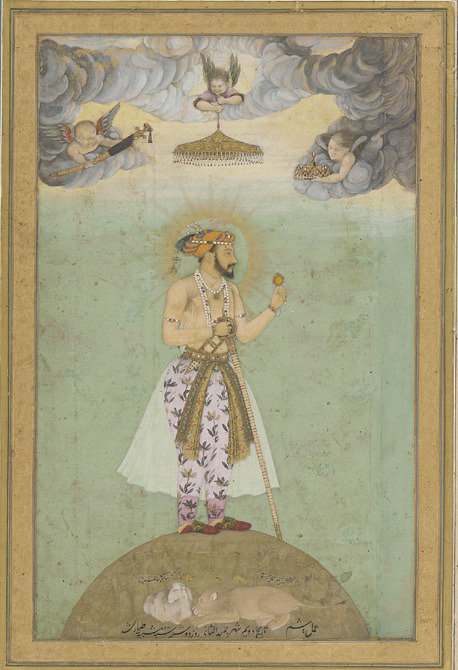
It was used by e.g. the ancient Greeks, Mughal emperors and, while the methods and it's production was systematically being destroyed by the British to squash competition, it became super fashionable in Europe. It was extremely expensive, even more so than silk, which is probably why it became so popular among the rich. In 1780s Marie Antoinette famously and scandalously wore chemise a la reine made from multiple layers of Dhaka muslin. In 1790s, when the empire silhouette took over, it became even more popular, continuing to the very early 1800s, till Dhaka muslin production fully collapsed and the knowledge and skill to produce it were lost. But earlier this year, after years lasting research to revive the Dhaka muslin funded by Bangladeshi government, they actually recreated it after finding the right right cotton plant and gathering spinners and weavers skilled in traditional craft to train with it. (It's super cool and I'm making a whole post about it (it has been in the making for months now) so I won't extend this post more.)


Marie Antoinette in the famous painting with wearing Dhaka muslin in 1783, and empress Joséphine Bonaparte in 1801 also wearing Dhaka muslin.
While the trans-Atlantic slave trade was partly funded by the cotton trade and industrial English cotton, the slave trade would also be used to bolster the emerging English cotton industry by forcing African slaves to work in the cotton plantations of Southern US. This produced even more (and cheaper (again slave labor)) raw material, which allowed the quick upward scaling of the cotton factories in Britain. Cotton was what really kicked off the industrial revolution, and it started in England, because they colonized their biggest competitor India and therefore were able to take hold of the whole cotton market and fund rapid industrialization.
Eventually the availability of cotton, increase in ready-made clothing and the luxurious reputation of cotton lead to cotton underwear replacing linen underwear (and eventually sheets) (the far superior option for the reasons I talked about here) in early Victorian Era. Before Victorian era underwear was very practical, just simple rectangles and triangles sewn together. It was just meant to protect the outer clothing and the skin, and it wasn't seen anyway, so why put the relatively scarce resources into making it pretty? Well, by the mid 1800s England was basically fully industrialized and resource were not scarce anymore. Middle class was increasing during the Victorian Era and, after the hard won battles of the workers movement, the conditions of workers was improving a bit. That combined with decrease in prices of clothing, most people were able to partake in fashion. This of course led to the upper classes finding new ways to separate themselves from lower classes. One of these things was getting fancy underwear. Fine cotton kept the fancy reputation it had gained first as an exotic new commodity in late 17th century and then in Regency Era as the extremely expensive fabric of queens and empresses. Cotton also is softer than linen, and therefore was seen as more luxurious against skin. So cotton shifts became the fancier shifts. At the same time cotton drawers were becoming common additional underwear for women.
It wouldn't stay as an upper class thing, because as said cotton was cheap and available. Ready-made clothing also helped spread the fancier cotton underwear, as then you could buy fairly cheaply pretty underwear and you didn't even have to put extra effort into it's decoration. At the same time cotton industry was massive and powerful and very much eager to promote cotton underwear as it would make a very steady and long lasting demand for cotton.
In conclusion, cotton has a dark and bloody history and it didn't become the standard underwear fabric for very good reasons.
Here's couple of excellent sources regarding the history of cotton industry:
The European Response to Indian Cottons, Prasannan Parthasarathi
INDIAN COTTON MILLS AND THE BRITISH ECONOMIC POLICY, 1854-1894, Rajib Lochan Sahoo
#i have fixed the wording in the beginning so it doesn't sound like i'm saying cotton in general dyed better than wool or silk#answers#fashion history#historical fashion#history#textile history#dress history#historical clothing#indian history#colonial history#indian textiles#cotton#slavery
2K notes
·
View notes
Note
Hi, I want to ask if you have any topics about the Philippine-American War? I have gotten myself in Philippine History and I want to know deeper. Thanks:)
I was thinking of many ways on how to answer this because this is such a large and complicated topic but I could just try to summarize some stuff here and tell you what I know and what I could find.
The Filipino-American war mainly started as Filipinos felt betrayed by their former American allies after the country was sold to them by Spain after the Spanish-American war during the Treaty of Paris of 1898 for $20 million alongside other Spanish colonies like Puerto Rico, Guam, and Cuba (American Historical Association, n.d.). This feeling of betrayal had come from the fact that the leader and dictator president of the Filipino revolutionaries, Emilio Aguinaldo of the Kataastaasang Kagalang-galang Katipunan ng mga Anak ng Bayan (en. The Supreme and Honorable Association of the Children of the Nation) or the Katipunan for short, actually sought assistance from the Americans in Hong Kong during the Filipino Revolutionary War against Spain which was happening at the same time (Kedmey, 2013). This is why tensions were so high with the Americans when they first formally colonized the Philippines.
Interestingly, the purchase also included some territories that weren't actually part of Spanish rule such as the Sultanate of Sulu as well as some indigenous territories which led to a strained relationship with the Americans moving forward such as the independent Moros of Muslim Mindanao later being forced to assimilate to the rest of the colony of the Philippines despite previous agreements that state that they will leave them alone, mirroring the way the United States government treated Native Americans (Gowing, 1968).
Fighting between the American army and the Filipino army first broke out when on February 4, 1899 after Private William W. Grayson fired at 4 Filipino soldiers who cocked their rifles in response to them ordering the men to halt which later broke out into the Battle of Manile of 1899 (Chaput, 2012). As the Filipinos and Americans declared war on each other, the Katipuneros resorted to the mountains to start guerilla warfare against the American army (Philippine-American War, n.d.) which then lasted until 1901 when Aguinaldo was captured on March 23, 1901, just a day after Aguinaldo's birthday actually with the capture being attributed to two of his men, Lazaro Segovia and Hilario Tal Placido who betrayed him to the Americans with his other men still being too relaxed from the festivities the day before (Ocampo, 2010).
The fighting continued despite his capture and surrender until the last of the generals, General Macario Sakay, surrendered in July 14, 1906 who was then later executed along side his men on September 13, 1907 despite the initial promise of amnesty by the American government (Pangilinan & Pimintel, 2008).
The war ended the lives of 4,300 American soldiers with only 1,500 having been killed in action with the rest succumbing to diseases, while Filipino forces suffered 20,000 casualties alongside the death of 200,000 Filipino civilians due to hunger, disease, and combat (Philippine-American War, n.d.).
The violence of the situation and especially committed by the American soldiers prompted a lot of protests in the United States to stop the war immediately, as letters of the situation had been sent back to their homes which describes in excruciating detail the war crimes that these soldiers were ordered to commit such as blockading and burning down villages, extreme torture of captured and suspected enemies, and much more. The most well-known of these torture methods that I remember being taught to us in history classes as early as 4th grade was the "Water Cure" where American soldiers would force water down the victim's throat in and force them to vomit it back out. This article has a detailed account of the exact nature of this torture method as it discusses the torture of Mayor Joveniano Ealdama of Igbaras, who, although no American troop was actually hurt in his town, was tortured with his town being burnt down by the Americans the very next day (Vestal, 2017).
I do have to be honest, I was utterly shocked at how little Americans really knew about the Philippine American colonial era and by extension the Philippine-American war especially with the sheer amount of brutality the Americans had done to Filipino locals as well as the large impact the American government and American culture has had in my country and I am glad that more and more people are starting to learn more about this but it's still rather disappointing.
Videos on the Philippine-American War
If you want to learn more about the Philippine-American War, I have a couple of recommendations for videos that you can watch.
This video by Crash Course explains the origins of American Imperial idealization as well as the wars that led up to the colonization of the many territories that America acquired during this time era:
youtube
Here's a good summary by history teacher Mr. Beat of the major aspects of the war as well as the American public's perception of it that you can watch:
youtube
Here's a video made with a Filipino-perspective by Jonas Tayaban on the topic:
youtube
Here's a summary in Tagalog. It doesn't have English subtitles though but it does detail more things about the build-up and the subsequent wars between Spain and America and later the Philippines and Spain and then America too:
youtube
Movies about the Philippine-American War
I would also be remiss to not suggest some historical movies that tackle the events of this time period and especially TBA Studios' Artikulo Uno films Heneral Luna (2015) which focuses on the most popular and effective general of the revolution Gen. Antonio Luna, and Goyo: Ang Batang Heneral (2018) which focuses on Gregorio "Goyo" del Pilar, one the youngest generals of Filipino history who died a very tragic death at a young age:
youtube
You can watch the full movie here complete with English Subtitles
youtube
Another well-known movie about this time period is Viva Films' El Presidente (2012), although I had heard people say it's very much biased to the controversial dictator president Aguinaldo's side with many people citing that as the reason why they don't like the film.
youtube
Here's a reupload of the full-movie. It doesn't have subtitles though.
I don't know of any American-made movies that focuses on this topic and I know there's several other films that focus more on the politics of the Katipunan and the Filipino Revolutionary War against Spain, but not necessarily the Philippine-American War so if anyone has other suggestions, please let me know.
I would also like to suggest documentaries but most of the ones I've seen are on World War II and the others are other YouTube videos by history channels that I'm not too familiar with made by mostly white American YouTubers. Not that that would disqualify their videos (I did reference both John Green and Mr. Beat here) but I don't know these history channels and their hosts enough to recommend them in good faith as of right now.
Books and Further Reading on the Philippine-American War
For books on the subject, I often reference the many writings of Ambeth Ocampo such as his Looking Back series, specifically:
Looking Back 2: Dirty Dancing (Shopee, Lazada, Amazon)
Looking Back 11: Independence x6 (Shopee, Lazada)
Looking Back 13: Guns of the Katipunan (Shopee, Lazada)
I'm also currently interested in buying some other books about the topic like The Hills of Sampaloc: The Opening Actions of the Philippine-American War, February 4-5, 1899 (Shopee, Amazon) but I don't really have any extra money to spare for it right now.
I remember that my father had some other books about this too but the names had escaped me and it's far too much work to try to sort out through his entire book pile in our house.
I hope this answer's comprehensive enough since the subject is, as I said before, quite complex and rather large so I can't really get into all the specifics right now.
References:
American Historical Association. (n.d.). How Did America Enter the Picture?. Retrieved on 3 February 2024, from https://www.historians.org/about-aha-and-membership/aha-history-and-archives/gi-roundtable-series/pamphlets/em-24-what-lies-ahead-for-the-philippines-(1945)/how-did-america-enter-the-picture
Chaput, D. (2012). Private William W Grayson's War in the Philippines, 1899. Retrieved on 3 February 2024, from https://ne-test-site8.cdc.nicusa.com/sites/ne-test-site8.cdc.nicusa.com/files/doc/publications/NH1980GraysonWar1899.pdf
Gowing, P. (1968). Muslim-American Relations in the Philippines, 1899-1929. Retrieved on 3 February 2024, from https://asj.upd.edu.ph/mediabox/archive/ASJ-06-03-1968/gowing-muslim-american%20relations%20in%20the%20philippines%201899-1920.pdf
Kedmey, D. (2013, June 13). Exiled in Hong Kong: Famous Company for Edward Snowden.Time. Retrieved on 3 February 2024, from https://world.time.com/2013/06/15/exiled-in-hong-kong-famous-company-for-edward-snowden/slide/general-emilio-aguinaldo/
Ocampo, A. (2010). Looking Back 2: Dirty Dancing. Anvil Publishing
Pangilinan, F., & Pimintel, A. (2008, September 9). A Resolution Expressing the Sense of the Senate Honoring the Sacrifice of Macario Sakay and all other Filipinos who Gave Up their Lives in the Philippine-American War for our Freedom, Senate Resolution No. 623, 14th Congress of the Republic of the Philippines. Retrieved on 3 February 2024, from http://legacy.senate.gov.ph/lisdata/83927584!.pdf
Philippine-American War. In Britannica. Retrieved on 3 February 2024, from https://www.britannica.com/event/Philippine-American-War
Vestal, A. (2017). The First Wartime Water Torture by Americans. Retrieved on 3 February 2024, from https://digitalcommons.mainelaw.maine.edu/mlr/vol69/iss1/2/
#filipinfodump#filipino history#american history#history#filipino-american history#philippine-american war#military history#colonial history#imperialism#american imperialism#american colonization#american colonial era#philippines#america#filipino#katipunan#us military#president emilio aguinaldo#general antonio luna#general gregorio del pilar#filipino heroes#filipino presidents#john green#crash course history#crash course american history#mr. beat#jonas tayaban#moobly tv#filipino movies#heneral luna (2015)
77 notes
·
View notes
Text
“ALL INDIGENOUS PEOPLES DESERVE SELF DETERMINATION IN THEIR HOMELANDS!!!”
My brother in Christ you can’t even acknowledge Israel’s right to exist and the thought that Jews are native.
P.S. the thought that only one group can be indigenous to a piece of land IS colonial thinking. Both Israelis and Palestinians are indigenous to the land, deal with it.
#jumblr#Israel#jews are native to israel#israeli palestinian solidarity#i stand with palestine#free Palestine#am israel hai#antisemitism#say no to settler colonialism#colonialism#colonization#colonial history#first nations#native americans#Palestine
42 notes
·
View notes
Text
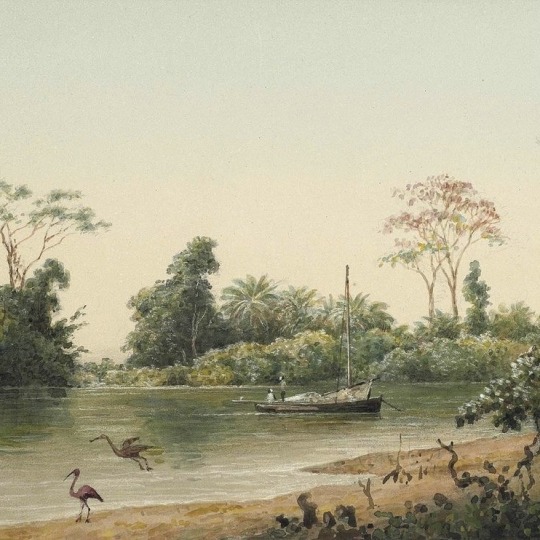
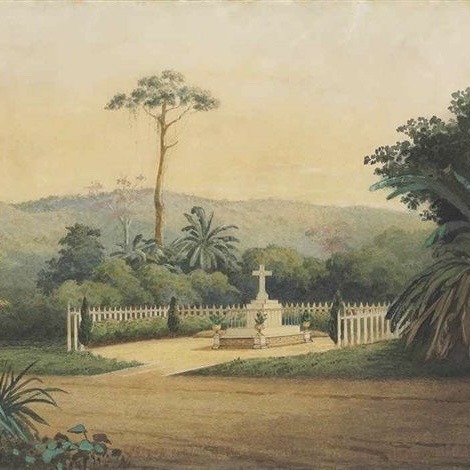
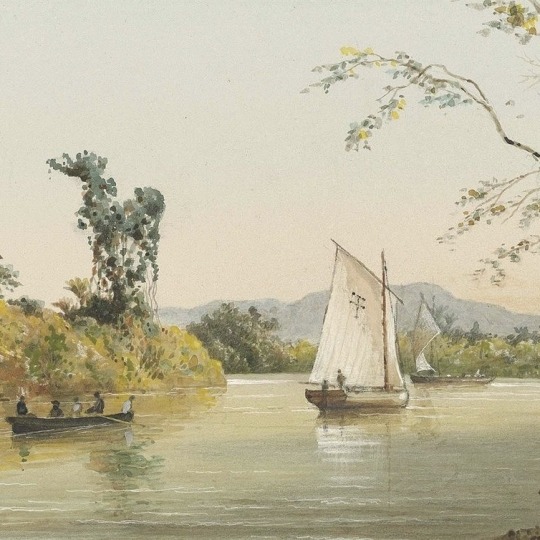
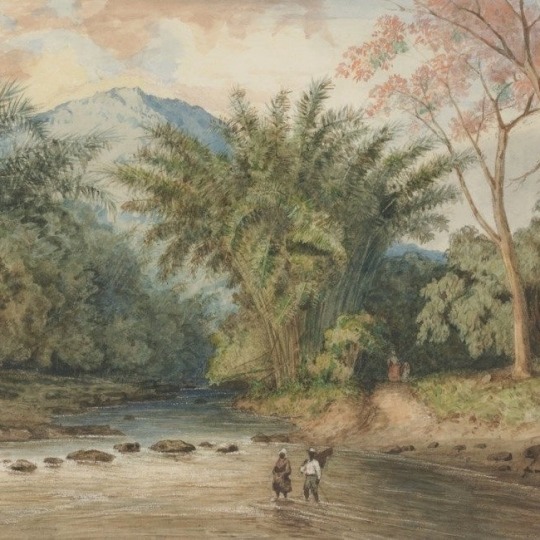
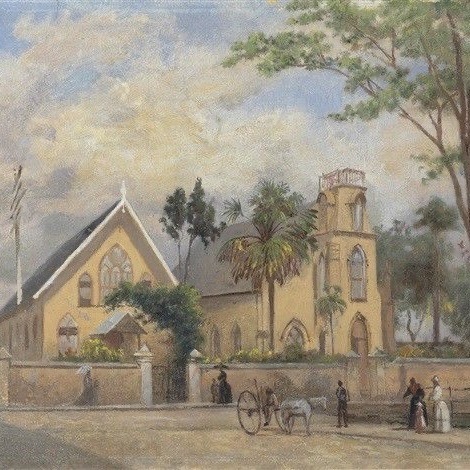



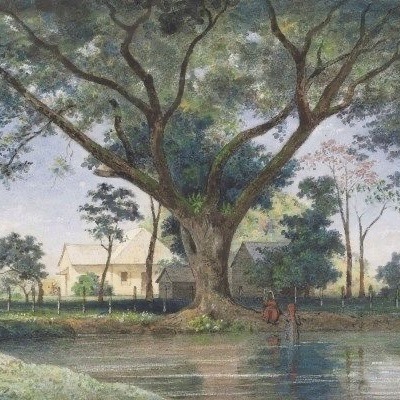
Artists: Michel-Jean Cazabon (1813-1888)
#michel-jean cazabon#fine art#colonial history#trinidad and tobago#caribbean#west indian#french artists#creole#english history#landscape#landscape painting#cottagecore#tropical aesthetic#peaceful atmosphere#forest#forest aesthetic#summer aesthetic#peace and quiet#countryside#country landscape#rural areas#art#history of art#caribbean history#colonialism#art blog#moodboard#art moodboard
78 notes
·
View notes
Text

Brighton & Hove News, 28 July 2023:
'A Brighton family have literally stopped traffic with a new mural inspired by a sari pattern on their new home.
Poppy Jaman and Jaan Madan moved to Southampton Street in Hanover in January, and immediately knew they wanted to make a splash when decorating the outside.
She said: “One of the reasons we wanted to move to the centre of Brighton is that it’s so colourful.
“We were inspired by murals in Washington where there’s a whole area where there’s murals which have been created out of adversity.
“That inspired the idea of making a statement with our home. I wanted to not just paint something that I love. If you just love something that’s enough, but I also wanted to say here’s a bit of my identity.
“I collect saris and Jamdani is a signature saris of Bangladesh. It’s got a colonial past to it.

📷 X
The mural is inspired by the Jamdani weave saree, the signature saree of Dhaka, Bangladesh, which dates back at least as far back as 300BC.
Between the 16th and 19th centuries, Jamdani fabric – so fine it was known as ‘woven air’ – was one of the most highly coveted commodities in Mughal courts and further afield. However, by the mid-19th century, Jamdani had become almost extinct.
Poppy has written more about her relationship with the Jamdani design and its colonial history here.'
#sari#mural#brighton#mughal#textiles#textile history#jamdani#dhaka#bangladesh#colonial history#indian history#weave#woven fabric#pattern#surface pattern#surface pattern design#pattern design#textile design#surface decoration#street art#uk#england#british asian#saree#traditional crafts#traditional textiles#traditional clothing#bengali#weaving
124 notes
·
View notes
Text
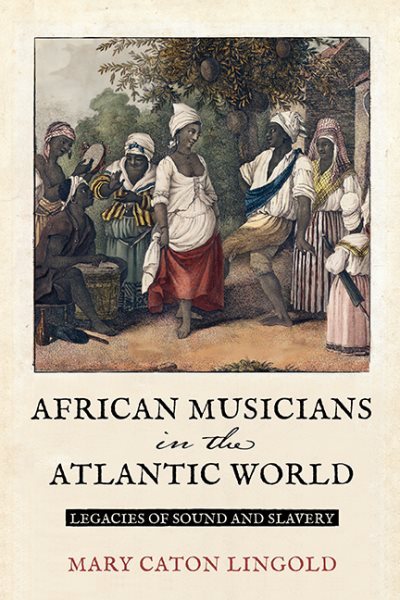
"A rich, well-written and well-researched book on a novel and important topic. African Musicians in the Atlantic World will make a major contribution to multiple fields, including music history, Atlantic studies, colonial Caribbean history and literature, as well as studies of transatlantic slavery, the African diaspora, and Black culture in the Americas. It is full of fascinating archival discoveries and insights."
#uwlibraries#history books#african americans#history of music#caribbean history#colonial history#history of slavery
34 notes
·
View notes
Text
"Scream To Let Your Voice Be Heard", by Salome MC.
The music video is unavailable at YouTube now, but this was the description:
───
June 07, 2009 — This is a Persian Rap song made by Salome, Iranian rapper. The song is written after Gaza Attack.
───
CW for video: Gaza invasion 2009 depicted
#Scream To Let Your Voice Be Heard#Salome MC#music#161#1312#lovemusichatefascism#video#rap#hiphop#hip hop#palestine#gaza#free palestine#freepalastine🇵🇸#free gaza#gaza strip#gaza genocide#gazaunderattack#genocide#no pride in genocide#class war#anti colonialism#anti colonization#anti imperialism#colonialism#colonial violence#colonizers#colonial history#colonial america#israel
21 notes
·
View notes
Text
The Haitian Revolution
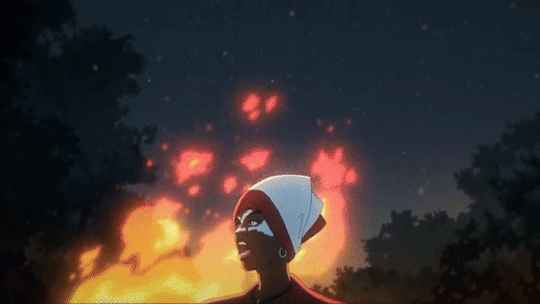
Yeah, okay. I guess to properly do the history thing, I also have to talk about the Haitian Revolution, don't I? Given that it is so important for the backstory of both Annette and Edouard.
Why didn't I do that so far? Because the Haitian Revolution is super hard to talk about because of the sources. A bit issue is that for a good part of it we only have French sources, that are not always the most... neutral. Because a lot of the rebelling slaves had never learned to write. As such, we actually do not know a lot about the side of the rebels until some Free Blacks started to take their side and lead the rebellion.
But I know a bit.
So, let me explain what I know.
Haiti (St. Domingue specifically, the French side of the island) was build exclusively on slave work. There were plantation there for indigo, sugar and coffee for the most part. And those plantation were very important for the French economy. And of course it was slaves working those plantations.
On the island there was a three class system (though if we are honest, it was a four class system).
Whites, who were free people and citizens of France. (Though in truth there was a difference between the plantation owning whites and those whites, who were not of the owning class.)
Free Black people. What differed in Haiti from the US for example is that it happened quite often that children of rape (white owners on Black slaves) would be freed and even adopted as children. While not considered citizens, they could own things, including their own plantations. (Yes, there were quite a few of these that owned slaves.)
Slaves, who outnumbered all other people on the island somewhere between seven to one and ten to one.
Now, most slaves did not survive the first three years after getting to the island. Many died in fact in their first year, because the working conditions were so harsh, they often did not receive food, were severely punished (through it receiving infections and such), and of course there was just the general issue of sicknesses.
There were people rebelling a long while and from what we know (again, there is so little in terms of sources) there were some escaped slaves living in the mountains and at times using guirella tactics. But there was not quite the move for a widespread rebellion starting...
That was until the French Revolution started. Once more the gentle reminder: The French Revolution took a long while to brew and originally was not a violent revolution, it only became violent in response to the violent oppression of it. Now, the people on St. Domingue were instructed not to talk about the Revolution, because some folks rightly assumed that it might give people ideas. Especially as among the Revolutionaries there was a big discussion about the abolition of slavery.
But in the end... Well, it did not work out and the freed slaves banded together for a proper uprising in 1791.
It is this uprising that we see in Nocturne. I have seen some people being very shocked in the human on human violence we see there, because folks are really whimpy when it comes to that. So, a little explanation: Originally (in the 1791) uprising the slave uprising was once again not very violent. Almost everyone who got killed was connected to immense abuses of slaves. The rebels tried to spare everyone who treated their slaves kindly. As such within that first uprising only 400 whites got killed, compared to 4000 Black people, as the French were much better armed.
Still, the rebels managed to capture part of the island.
It should be noted: This is probably around the time when Annette and Edouard left. They captured some plantation, and freed quite a few more slaves.
There would follow quite a bit of back and forth then. Especially between Haiti and the French Republic. And I would not be surprised if we were to see that in the coming season(s).
Mostly, because the Revolitionaries went back and forth between whether Free Black people could be citizens who got to vote or not. Making the Free Blacks, who originally were against the revolution, more and more take the side of the rebels.
And yes, it would get more and more violent. Because France and then later Britain, too (who did not agree with France on many things - but on saving slavery) threw thousands upon thousand of soldiers in fighting down the revolution with extreme violence, leading the Haitian Revolutionaries to answer this violence with their own violence.
But for the love of God, do not go there and be like: "Ugh, violence. Violence bad." Like, fuck that. I said that about Isaac before as well: Slaves freeing themselves have the right to use whatever violence necessary for that.
#castlevania#castlevania netflix#castlevania nocturne#haiti revolution#haiti#colonial history#slavery#castlevania annette#castlevania edouard
367 notes
·
View notes
Text
Notes on "Empire of Care : Nursing and Migration in Filipino American History"

Filipino nurse migration to the United States is just one aspect of a larger global flow of predominantly female migrants from the Philippines to over 130 countries.
This migration trend contrasts with early Philippine immigration, which consisted mainly of male labourers to the United States

The migration of highly skilled nurses across borders is both a celebratory sign of their training and expertise but also highlights global power dynamics, where nurses from countries with severe nursing shortages migrate to provide care in highly developed countries like the United States, Canada, and the United Kingdom.
Despite the important role of Filipino nurse migrants, little is known about their development and experiences.
Existing studies often group Filipino nurse migrants with other Asian professional migrants, which masks the unique aspects of their migration.
These studies often explain Filipino nurse migration through U.S. immigration legislation and economic opportunities, such as the 1965 U.S. Immigration Act and nursing shortages after World War II.
The "brain drain" theory is commonly used to explain professional migration from Asian countries, suggesting that professionals leave due to a lack of opportunities and economic incentives in their home countries.
Filipino nurse migrants are sometimes depicted as impersonal objects of study, preventing a comprehensive understanding of their multidimensional roles as historical agents, professionals, women, and immigrants.
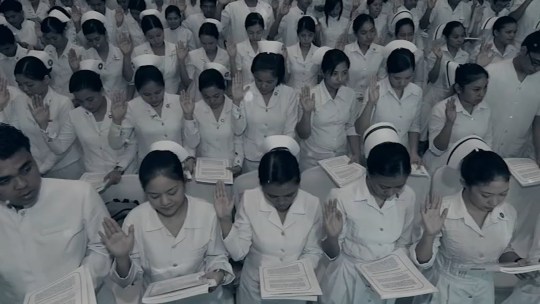
The migration of highly skilled nurses reflects a global power structure where countries with nursing shortages, including the Philippines, send nurses to provide professional nursing care in highly developed countries like the United States, Canada, and the United Kingdom. The World Health Organization (WHO) report highlights the inequitable distribution of nurses worldwide, with developing countries having only 15 percent of the world's nurses despite housing two-thirds of the world's population (Empire of Care).
The culture of migration, shaped by narratives about the promise of immigration to the United States, including media portrayals and experiences shared by Filipino nurse migrants already in the U.S, plays a significant role in motivating Filipino nurses to seek opportunities abroad.
U.S. hospital recruiters actively collaborate with Philippine travel and recruitment agencies to aggressively recruit Filipino nurses, shedding light on what some researchers call the "institutionalisation of migration." However, these aspects are often overlooked in research, leaving a "critical void" in understanding the dynamics of Filipino nurse migration.
The lack of study about the exploitation faced by Filipino nurses from both Philippine and American recruiters and their American hospital employers is concerning. Additionally, the scapegoating of Filipino immigrants during challenging political times and the absence of professional solidarity between Filipino and American nurses remain underexplored issues.
The studies that include Filipino nurse migrants also marginalise and simplify the complex and dynamic history of the colonial relationship between the United States and the Philippines.
Pervasive myths of U.S. exceptionalism and benevolence persist and influence the perception of colonial history, downplaying the violent conquest of the Philippines and the racialized hierarchies it created. These myths are also perpetuated in contemporary times through media narratives about immigration and the incorporation of the "Third World" into the United States.
Despite their highly educated and skilled backgrounds, professional Asian immigrants, including Filipino nurses, still face resentment and hostility, as exemplified by the case of nuclear physicist Wen Ho Lee.

Foreign nurses, especially Filipino nurses, have been criticised for "taking jobs" from American nurses, leading to debates about their immigration and examination requirements. This criticism often overlooks the complex factors involved in Filipino nurse migration and the collaboration between Philippine and U.S. entities in facilitating the process. It also implies that Filipino nurses exploit the United States, rather than the reality of the situation (the United States exploiting Filipino nurses).
The history of U.S. colonialism in the Philippines perpetuated the interrelated myths of "white love" and "little brown brothers." These myths claimed that Americans embraced their colonial subjects with benevolence and enlightened American systems of education, infrastructure, and public health. Not only does this further promote the myths of American benevolence and American exceptionalism , it portrays Americans as superior to their Filipino counterparts in a racialised hierarchy.
American Exceptionalism in this context means Americans juxtaposing themselves against their "Brutal, European counterparts" in order to paint themselves as a benevolent force in the Philippines.
#Empire of care#Philippines#the philippines#Filipino history#filipino american#Pinoy#Filipino#Filipina#us colonialism#us imperialism#US exceptionalism#Colonialism#Colonial history#History#Asian history#American history#Books#My books#Personal#🇵🇭#Swagapino#I shuddered upon typing “little brown brothers” and “white love” LMAOOO#Started this last night and finished it like 10 mins ago#I also laughed upon reading that American nurse complaining about Filipino nurses implying that Filipinas were exploiting the US#The audacity
92 notes
·
View notes
Text
Palestinian History Between Great Powers - Part 1
From Bronze Age to Ottoman Palestine
I started writing this article months ago but as it deserves proper research, it took me a long while, and at one point I started questioning is this helpful anymore. I thought it's obvious at this point to anyone not willfully ignorant that what we are seeing in real time is a genocide, and I'm not going to convince those who are willfully ignorant. I decided to finish it anyway since I do feel obligation to do something and maybe providing some accessible historical context is what I'm capable of doing. Even if I probably won't change any hearts and minds, I think the least we can do is not forget Palestinians and fall into apathy. And at the very least more understanding of the situation is always better even when we already oppose this genocide.
This is quite out of my area of focus, so I will be doing more of a general overview of the history and link in depth sources by more knowledgeable people than try to become an expert on this. My purpose is to offer an accessible starting point for the history of Palestine to help people put historical and current events into their proper context. I don't think the occupation and genocide in Palestine pose complex moral questions - it's pretty simple in my opinion that genocide, apartheid and colonialism are wrong and need to stop for peace to be possible - but the history is complex and it's understanding needs quite a lot of background. I will do my best to represent the complexity accurately and fairly while keeping this concise. Since there is a lot of history, even if this is very general overview, it's still very long, so I did need to cut this in two parts. First part will be covering everything to the beginning of WW1, second part the British Mandate period and Israel period.
Bibliography
I'm linking my sources and further reading here so it's easy to check some specific resources even if you don't want to/have time to read 5 000 years of history right now. Because there's so much misinformation and propaganda, I read as much as I could from academic sources, linked at the top here. They are really interesting and delve deeply into specific subjects so I do recommend checking out anything that peaks your interest (Sci-Hub is your friend against paywalled papers and in JSTOR you can make a free account to access most papers). Some of them I didn't really end up using, but I still linked them here since they provide some additional context that wouldn't fit in this overview. At the end there's some accessible resources (youtube videos, podcasts etc.) which are relevant and I think good.
Pre-Ottoman Era
On The Problem of Reconstructing Pre-Hellenistic Israelite (Palestinian) History - Critique of Biblical historical narratives
Canaanites and Philistines
Archaeological Sources for the History of Palestine: Between Large Forces: Palestine in the Hellenistic Period - Everyday life in Hellenistic Palestine
Ottoman Era
Rediscovering Ottoman Palestine: Writing Palestinians into History - Critique of politics of Ottoman Palestine historiography
The Peasantry of Late Ottoman Palestine
Consequences of the Ottoman Land Law: Agrarian and Privatization Processes in Palestine, 1858–1918
The route from informal peasant landownership to formal tenancy and eviction in Palestine, 1800s–1947
The Ottoman Empire, Zionism, and the Question of Palestine (1880–1908)
Origins of Zionism
Christian Zionism and Victorian Culture
Zionism and Imperialism: The Historical Origins
The Non-Jewish Origin of Zionism
Zionism and Its Jewish "Assimilationist" Critics (1897-1948)
The Jewish-Ottoman Land Company: Herzl's Blueprint for the Colonization of Palestine
Books
Boundaries and Baraka - Chapter II of Muslims and Others in Sacred Space - Local syncretic religious beliefs of Muslim and Christian Arabs in Palestine
Further "reading"
Israelis Are Not 'Indigenous' (and other ridiculous pro-Israel arguments) - Properly cited youtube video on settler colonialism of Zionism (Indigenous is defined here in postcolonialist way, in contrast with the colonialist, the video doesn't argue that diaspora Jews didn't originate from the Palestine area)
Gaza: A Clear Case of Genocide - Detailed Legal Analysis - Youtube video detailing current evidence on the ongoing genocide and assessing them through international law
What the Netanyahu Family Did To Palestine: Part 1 , Part 2 - Two part podcast episode of Behind the Bastards about Israel's history and Netanyahu Family's involvement in it with an expert quest
History of Israeli/Palestinian conflict since 1799 - Timeline of Palestinian history by Al Jazeera with documentaries produced by Al Jazeera for most of the entries in the timeline
Ancient Era (33th-4th century BCE)
Palestine's location in the fertile crescent, the connecting land between Africa and Asia and the strip of land between Mediterranean and Red Sea means since the earliest emergence of civilizations it has been in the middle of great powers. Thorough it's history it has been conquered many, many times for it's strategic value. Despite the changing rulers and migrating groups there has been a continuous history history of a people, which has changed, split and evolved, but not fully disappeared or replaced at any point, which is quite rare of a history spanning thousands of years.
Speakers of Semitic languages are the first recorded inhabitants of Palestine. At least from Bronze Age (c. 3300-1200 BCE) onward they inhabited Levant, Arabian peninsula and Ethiopian highlands. Semitic languages belong in the Afroasiatic language group, which includes three other branches; ancient Egypt, Amazigh languages and Cushitic languages of African Horn. Most prominent theories of the origins of proto-Afroasiatic is in Levant, African side of Red Sea or Ethiopia. In the Bronze Age the Levant's Semitic speakers were called Canaanites and there was already urban settlements in Early Bronze Age. Egypt had been extending it's control over Canaan for a while and in Late Bronze Age, 1457 BCE, it took over Canaan. Gaza, which had had habitation for thousand years already, became the Egypt's administrative capital in Canaan. Canaan stayed as Egypt's province until the Late Bronze Age collapse c. 1200-1150 BCE, when Egypt started losing it's hold on Levant. Egypt eventually retreated from Canaan around 1100 BCE. The causes of Late Bronze Age collapse are unknown, but theories suggest some kind of environmental changes that caused destruction of cities and wide-spread mass migration all around the East Mediterranean Bronze Age civilizations.
Canaanites was not what most of the people called themselves, but rather what the surrounding empires, especially Egypt and Hittites in the north, called them. Philistines appear in Egyptian sources around the Late Bronze Age collapse as raiders against Egypt, who were likely populating southern parts of Canaan, the Palestine area. Several groups with mutually intelligble languages emerged after Egypt left the area: in Palestine area Philistines, Israelites, in Jordan are Ammonites, Moabites and Edomites, and in Lebanon area Canaanites, who were called by Phoenicians by Greeks. Israelites have been theorized to split from Philistines, possibly after Aegonean migrants during the Late Bronze Age collapse influenced the culture of the costal Philistine city states, and/or through Israelites development of monotheistic faith. During Iron Age these different groups descendant from Caananites had their own kingdoms. In the area of Palestine there was two Israelite kindgoms, Kingdom of Judah is the highlands of Judah, were Israelites likely originated, and Kindom of Israel or Samaria north to it, as well as Philistine city states in the coast around the area of current Gaza strip.
Earliest historical evidence of Israel is from mid 9th century BCE and of Judah from 7th century BCE, though Israelites as a group were mentioned earlier. It's entirely possible the kingdoms predate these mentions, but the archaeological evidence suggests likely not by much. Israel was conquered by the Neo-Assyrian empire in 722 BC, so it's entirely possible kingdom of Judah was created by retreating Israelites of the earlier kingdom. The remaining Israelites under Assyrian rule came to be known as Samaritans, marking also the split of Jewish faith into Judaism and Samaritanism. Neo-Assyrian lingua franca was Aramaic, a Semitic language from southwest Syria, which became the major spoken language in Samaria. Judah became a vassal state of Assyrians and later Babylonians. After a rebellion Babylonians fully conquered Judah in 586-587 BCE and exiled the rebels, though more recent historical study suggests it targeted the rebelling population and was not a mass exile. In 539 BCE Babylon and by extension Judah was conquered by Persian Achaemenid empire, which allowed the exiles to return and rule Judah as their vassals. Persia also conquered Samaria and Philistines. Aramaic was also the official language of the both Neo-Babylonian and Achaemenid empires and replaces Old Hebrew as spoken language in Judah too, though Old Hebrew continued to be written language of religious scripture and is known today as Biblical Hebrew. Otherwise in the Palestine area there were Edomites, who migrated to the southern parts of former Judah kingdom, and Qedarites, a nomadic Arabic tribal federation, in southern desert parts.
Biblical narratives tell this early history very differently, and for a long while, those were used as historical texts, but more recent historical study has cast a doubt on their usefulness in historical inquiry. Even more recent archaeological DNA studies (like this and this) have supported the historical narratives constructed from primary historical texts.
Antique Era (4th century BCE - 7th century CE)
Under Persian rule the people in the Palestine area had a relative amount of autonomy, which lasted about 200 years. In the 330s BCE Macedonians conquered Levant along with a lot of other places. The Macedonian empire broke down quickly after the death of Alexander the Great, and Levant was left under the control of the Seleucid empire, which included most of the Asian parts of the Macedonian empire. During this time the whole Palestine area was heavily Hellenized. In the 170s BCE the Seleucian emperor started a repression campaign against the Jewish religion, which led to a Maccabean Revolt in Judea, lasting from 167-160 BCE until the Seleucids were able to defeat the rebels. It started with guerilla violence in the countryside but evolved into a small civil war. Defeat of the rebelling Maccabees didn't curb the discontent and by 134 BCE Maccabees managed to take Judea and establish the Hasmonean dynasty. The dynasty ruled semi-autonomously under the Seleucian empire until it started disintegrating around 110 BCE, and Judea gained more independence and began to conquer the neighbouring areas. At most they controlled Samaria, Galilee, areas around Galilean Sea, Dead Sea and Jordan River between them, Idumea (formerly Kingdom of Edom) and Philistine city states. During the Hasmonean dynasty Judaism spread to some of the other Semitic peoples under their rule. It didn’t take long for the rising power of the Roman Republic to make Judea into their client state in 63 BCE. Next three decades the Roman Republic and Parthian Empire would fight over control of Judea, which ended by Rome gaining control and disposing of the Hasmonean dynasty from power. It was a client state until 6 CE Rome incorporated Judea proper, Samaria, Idumea and Philistine city states into the province of Judea.
The Jewish population was very much discontent under Roman rule and revolted frequently through the first century or so. It led to waves of Jewish migration around the Mediterranean area, which would eventually lead to the formation of European and North-African Jewish groups. The Roman emperor’s decision to build a Roman colony into Jerusalem, which they destroyed along with Second Temple while squashing the previous revolt, provoked a large-scale armed uprising from 132-136 among Judean Jews, which Rome suppressed brutally. Jerusalem was destroyed again, Jews and Christians were banned from there, and a lot of Judean Jews were killed, displaced and enslaved. Rome also suffered high losses. Jews and Christians hadn’t yet fully separated into different faiths yet, but this strained their relations as Christians hadn’t supported the uprising. Galilee and Judea was joined into one province, Syria Palaestina. Galilean Jews hadn’t participated in the revolt and had therefore survived it unscathed, so Galilee became the Jewish heartland. During the Constantine dynasty, in the first half of the 4th century, when Christianity was the Roman state religion, Jerusalem was rebuilt as very Christianized. After the Constantine dynasty the Jewish relations with Rome were briefly improved by a sympathetic emperor, until Justinian came into power in 527 and began authoritarian religious oppression of all non-Christians, casting the whole area into chaos. Samaritans rebelled repeatedly and were almost fully wiped out, while Jews joined forces with several foreign powers in an attempt to destabilize Byzantium rule. By 636 the first Muslim Caliphate emerged as victors over the control of Palestine.
Muslim Period and Crusades (636-1516)
For more than 300 years under the rule of Muslim Caliphate, Palestine saw a much more peaceful period, with relative freedom and economic prosperity. Christianity continued to be the majority religion and Christians, Jews and usually Samaritans were considered People of the Book, who were guaranteed religious freedom. Non-muslims though had to pay taxes and depending on the caliph had more or less restrictions posed upon them. The position of Samaritans as People of the Book was unstable and at points they were persecuted. For the position of Jews it was a marked improvement, and after the expulsion of Jews from Jerusalem by Rome in the 2nd century, they were finally allowed to return. Jerusalem became a religious center for the Muslims too, as it was considered the third most holy place of Islam. Cities, especially Jerusalem, saw Arab immigration. The rural agricultural population was mostly Aramaic speaking, though even while Palestinian Arabs had mostly been bedouins in the southern deserts, there were few Arabic villages from the Roman era. People of the Book were protected from forced conversions, but over time conversions among the Christian population slowly increased, until Islam became the majority religion. Cities became Arabicized and slowly Arabic (also Semitic language) replaced Aramaic as the majority language. Towards the end of the first millennium persecution of Christianity increased with the threat of Byzantium.
In 970 a competing dynasty, Fatimids, conquered Palestine beginning a new era of continuous warfare and conquest by foreign powers. In the beginning of the new millennium Palestine was conquered by the Turco-Persian Seljuk empire for a couple of decades, recaptured by Fatimids for only a year, until the Crusaders took Palestine in 1099. During the next two centuries Palestine exchanged hands several times between the Crusaders and the Egyptian Ayyubid Sultanate. After internal struggle the Ayyubid dynasty was overthrown by the mamluk military caste and them in lead, the Sultanate secured Palestine. First they repelled the invading Mongol empire in 1260 and by 1291 they had defeated the remnants of the Cusaders and their Kingdom of Jerusalem. The period was devastating to the Palestinian populations, cities and economic life. The Crusaders especially committed numerous massacres against non-Christians and under Muslim rule Christians were persecuted and forcibly converted. The next two centuries under the Mamluk Sultanate were peaceful and Christian and Jewish communities were afforded some self-governance and relatively high religious freedom for being recognised as People of the Book again. The state had a more contentious relationship with Christians as the wars with the Crusaders were still looming between Christians and Muslims, and at some points Christians faced persecution and forced conversions.
Ottoman Period (1516-1917)
The Ottoman Empire gained dominance in western Asia over the Mamluk Sultanate during the late 15th century and conquered Palestine in 1516. It became a great imperial power in Asia and Europe for two centuries and in the 18th century started a slow decline, eventually becoming the "Sick man of Europe". The Ottoman Empire was very decentralized and under it Palestine was at first ruled by three Palestinian families semi-autonomously. The Ottoman state didn’t pay much attention to economic development, as they considered it contrary to their chivalric culture, so they instead attracted foreign businesses with the capitulation system. Capitulations were treaties between Ottomans and a foreign power by which the citizens of that foreign power were under their jurisdiction inside Ottoman borders. This guaranteed safety and religious freedom for non-Muslim merchants and exempted them from any additional taxes applying to foreigners and non-Muslims, which encouraged them to build businesses in the Ottoman Empire. Ottomans also intentionally attracted European Jews, who faced persecution and pogroms, and had built effective international trade networks through the tight knit diaspora communities. Jews and Christians had quite well secured position in the empire as People of the Book, but Samaritans were persecuted after they had sided with the Mamluk Sultanate against Ottomans and later for being considered "pagans". City elites adopted Turkish culture, while in rural areas peasant villages and Bedouin clans remained Arabic. The rural areas were very much self-governing as both villages and Bedouin clans were fairly self-reliant with their own political structures. Villages consisted of clan-like family groups, hamulas, and the village lands were distributed between their collective ownership.
In the 19th century the Ottoman Empire was leaving behind European imperial powers in economic and military development. With the rise of the international capitalist markets, capitulation approach, which had worked well for the empire in previous centuries, was extended to markets as a very laissez faire economic policy. This did not lead to hoped economic growth however, but rather deindustrialization. The Ottoman Empire opened itself to markets it couldn’t compete in and its resources were then easy to exploit by stronger economies. The other powers, such as the European powers, avoided this by first cultivating strong national industries with protectionist policies, and then opened to international markets. The capitulation system also became a political liability the way it interacted with the protégé system. The Ottoman Empire had agreed to allow some European powers to give their protection over certain minority religious groups (mostly Christian groups) in the Empire, allowing members of those groups to claim citizenship of their protectorate nation. This had allowed those Ottoman citizens to claim the benefits of the capitulation system and cultivated trade and business for the Empire. In the 19th century the European powers, notably France, British Empire, Germany and Russia, turned their interests towards Levant which was important for their access to their colonial interests in Asia and Africa. They had a vested interest in the continuing power of the weakening Ottoman Empire, which they believed they could control through economic dominance and the protégé system. It became a competition on who could gain the most influence in the Ottoman Empire. In Palestine this led to a change in class dynamics. Christian protégés of European imperial powers were given tax exemptions from the increasing taxes, which were implemented to balance the national deposit, and better opportunities to gain wealth from international trade, turning the urban Christian Arabs into elite.
In 1832 Egypt invaded Palestine, marking a point of more rapid decline of Ottoman rule. Egypt attempted to “modernize” Palestine, which was considered backward, but Egypt's policies, especially conscription, were considered intrusive. The local self-ruling clans and families were resistant to outside powers and with their sway over the population, they rose to a popular uprising after two years of Egyptian rule. The suppression of the uprising devastated many villages and Egypt still failed to enforce order and halt violence. In 1840 Britain intervened, returning its control back to the Ottomans. They didn’t yet have capitulations with the Ottomans and were concerned over the other European powers gaining influence over the aging empire, so in return for their military assistance, they gained capitulations and named Jews and Protestants as their protégés in Levant. Palestine rapidly opened to the international markets with the increase in capitulations combined with the laissez faire fiscal policies of the empire, allowing European powers to turn Palestinian cities, especially in the coast, to centers of trade. In 1858 the Ottoman Empire also attempted to privatize land ownership to increase agricultural production and profitability in order to help with their financial troubles. Most Palestinian land was public land, but in practice owned informally by the villagers cultivating it. As long as they paid taxes, they couldn’t be evicted, which rarely happened in those cases either, and their rights to the land were hereditary. The land reform codified and formalized land ownership and removed barriers to non-villagers gaining ownership of peasant land, laying groundwork for commodifying land. The Ottoman Empire also allowed foreigners to purchase private land. This didn’t immediately lead to large-scale transfer of land ownership, but increasing taxes impoverishing the peasantry and indebting them transferred land from its cultivators to urban absentee landlords. Peasants started to turn into landless tenants and a new type of large estates were established.
Birth of Zionism
The British pushed for more control over Levant, since they wanted to secure their access to India and their colonial ventures in Africa. They didn’t have much interest in colonizing Levant themselves, which is why they were interested in backing the Ottoman Empire and gaining stronger control over it via European Jewish immigrants. European Jews had been immigrating to Palestine in small numbers for a while for religious reasons, to escape persecution and to take advantage of the economic opportunities offered by the Ottoman Empire. The British though also had religious interests in supporting Jewish migration to Palestine. Since the early 19th century, there had been a growing religious movement of Christian Zionism, who sought to restore Jews into Palestine and then convert them to Christianity to cause the second coming of Jesus and the end times. As you do. They were considered fanatics, even lunatics, for their literal interpretations of prophecy, but they were enthusiastic imperialists and when they expressed the idea of restoration of Jewish Palestine in imperial terms, it gained popular acceptance in Britain. Some of the common talking points originating from Christian Zionism were Jews had the right to Palestinian land for Biblical reasons, the only way to not let the “underdeveloped” agrarian land go to waste was colonialism, and Jews would be a civilizing force in Palestine. While the end goal of Christian Zionists was conversion of Jews, they had Orientalist reverence for Jews, but among the wider imperialist support for these ideas there was in addition an explicitly antisemitic aspect. The imperialists' idea was that Britain, and Europe more broadly, could this way also get rid of the Jews.
The trouble was that at the time there was no wide interest at all among Jews to colonize Palestine. The Jews who were migrating there during the first half of the 19th century did so with all intentions of integrating to the Palestinian society. European Jews had since Enlightenment and the French Revolution gained unprecedented levels of social acceptance and equality (which still wasn’t very much), and liberal assimilationism had become the dominant ideology especially among Jewish elites. Assimilationist Jews considered Judaism a religious identity, not an ethnic one, and they rather identified with their nationality. In the latter half of 19th century Jewish socialism was contesting the liberal Jewish idea that antisemitism could be overcome with individualist approach and instead demanded structural change. During the century it became increasingly clear that the assimilationist approach couldn’t fix antisemitism as racial ideology and exclusionist ethnonationalism were gaining traction and fueling antisemitism, which culminated in the 1880s pogroms in Russia and 1894 Dreyfus Affair in France. These events certainly promoted socialist approach among many Jews, but the Jewish elite were certainly not interested in socialist solutions, where they would lose their elite status, even if for white Christians they were all second class citizens. So instead, like many elites facing the threat of socialism, they turned to nationalism. To the question of how to build a nation from a diverse diaspora, they found the answer from Christian Zionism. Jewish Zionism was distinctly secular, so while they did adopt many religious and biblical narratives and goals of Christian Zionism, they put them in nationalist terms. Their end goal was of course different from that of the millennialist Christians so Jewish Zionism was presented as a practical and rational alternative to utopian fanaticism, but they were still natural allies. Zionism was opposed in the European Jewish communities by both assimilationists and socialists, who both viewed it as countering the efforts of opposing antisemitism, which Zionists saw as an inherently impossible endeavor, and also by Orthodox Jews from a religious standpoint. Orthodox Jews denounced the secularization of the Promised Land, which according to them could only be bestowed by God and couldn’t be a state with secular power.
Before Zionism was fully formalized as a movement, there were proto-Zionist movements in Eastern-Europe as a direct response to the pogroms, with the goal of settling Eastern Jewish refugees to Palestine from 1881 forward. This is considered to be the start of the First Aliyah, the explicitly Zionist mass migrations to Palestine. The funding was secured from the European Jews, and with it the Zionists bought land from the absentee urban landlords with large estates and evicted the tenants in order to form Zionist colonies. This raised concern among Ottoman officials, who had become vary of the European exploitation of their capitulation system, which increased European influence with the immigration of European Jews. They were also concerned about the rising Arab nationalism in Palestine provoked by the European economic exploitation and even more pressingly the peasant displacement. The Ottoman Empire was already facing massive difficulties with nationalist movements in different parts of the empire, like in Armenia. They attempted to restrict Zionist land purchases with legal restrictions and failed.
The 1880s settling to Palestine was still unorganized and leaderless until Theodor Herzl, who is considered to be the founder of Zionism, joined Zionist ranks in mid-1890s and began formulating a colonialist venture in earnest. The British were supportive of the Zionist project, but as long as the Ottoman Empire was in charge of Palestine and the British could extend control over it, they weren’t interested in establishing such a state themselves. So the Zionist movement with Herzl in the lead turned to the Ottoman Empire in 1901. He envisioned the Zionist colonial project as a land company, modeled after the British and Dutch East Indian Companies, which would under imperial blessing operate fairly independently and govern over colonized land. The end goal was to build an ethnonationalist Jewish state and expel the native population. There were even dreams of Jewish empire that would colonize neighbouring countries, “civilize” them and bring them “prosperity”. To persuade the Sultan, Herz proposed to pay for the Ottoman Empire’s depts with European Jewish investments in exchange for allowing the Zionists to settle and govern Palestine. The Ottoman government was well aware of Zionist movement’s end goals and their alliances with European Imperialism, rejecting their proposals.
The Zionists evaded Ottoman restrictions anyway and continued to settle Palestine with British backing. European powers then pressured Ottomans to abolish those restrictions allowing a new wave of Zionist colonialism. The violence and pogroms in Russia had convinced some of the Eastern European Jewish socialists that fighting antisemitism was impossible, so they created Labor Zionism and used the “untouched land” to experiment with utopian socialist communes. In the process they displaced indigenous peasant hamulas, which had often for centuries farmed the land in communal ownership. Mass migration and eviction quickly provoked a predictable opposition in the Palestinian population and spread of Arab nationalist thought. This second wave of Aliyah ended at the First World War, which was also the end of the Ottoman Empire.
#history#palestine#palestinian genocide#palestinian history#colonization#colonial history#zionism#islamophobia#ottoman empire
162 notes
·
View notes
Text
Scottish people were absolutely *both* victims of Empire *and* willing participants in the oppression of it.
One of the things I keep trying to do as a white Scot is encourage other white Scots to internalise both sides of this and stop blaming *all* the oppressions perpetrated by the Empire on the English.
It’s absolutely morally and politically necessary to be willing to acknowledge and make moral and economic reparations for the ways we as modern Scots benefit from past colonialist oppression. I’m very much for Scottish independence and I consider that an absolutely essential prerequisite for an independent Scottish state.
129 notes
·
View notes
Text
The zionist entity has no right to exist
It would be dismantled piece by piece. Gaza, West bank, Jerusalem, Haifa, Tel aviv... Like it or not. Cry, yell, curse, vociferate, invent more lies, blackmail, humiliate, torture, quote the bible, kill more babies in vain, roll on the floor in antisemitism. And the higher the pills of deaths to impose your domination the more enemies you create even within your allies. My words make you laugh? It's fine, Hubris always comes before the fall. You don't see it yet but it's coming. This is the natural direction of history. Zionists leaders harshly punished, their zealous followers send back from the 2348938457 countries they, their parents or their grandparents comes from. And for those left, if the indigenous Palestinians still wants you around and if you accept to live in a real democracy with equal rights for Muslims, Christians and Jews, you might stay. But it's up to them!
To those who choose humanity: don't despair! The tyranny will end, the beast is always the most vicious and dangerous when deadly wounded. Be resilient and patient. It happened in Apartheid South Africa, in French Algeria, in Rhodesia now Zimbabwe, in India, in Indochina now Vietnam. and so much more decolonised countries. The settlers left, some stayed and accepted to integrate into the native society.
Too much blood has been spilled in Gaza (5% of the total population in February 2024), too much innocent children have been sacrificed, too much people around the world have seen disgusting images we wish we have never seen. We are fed up, so fed up by the utter arrogance of the evil entity from their degenerate leaders to their citizens happily doing rave party while blocking aid trucks and creating famine few miles away... There is no coming back. Don't you understand? This is the last racist colony in the world. And this is the world war of our generation.
Humanity against Evil.
#from the river to the sea palestine will be free#israel#anti zionisim#gaza#west bank#palestine#zionism#colonialism#colonial violence#colonial history#south africa#vietnam#zimbabwe#algeria#india#indochina#racism#genocide#ethnic cleansing
16 notes
·
View notes